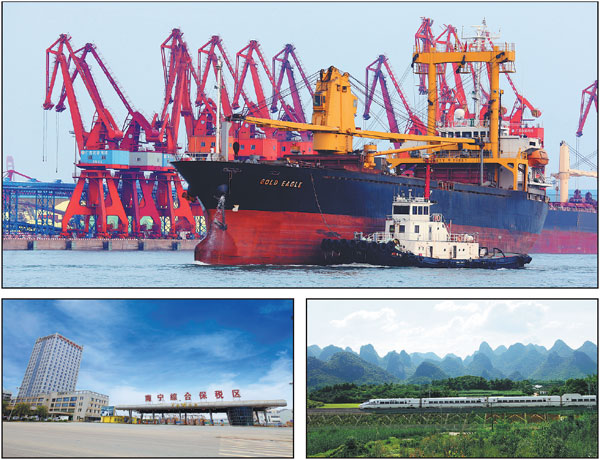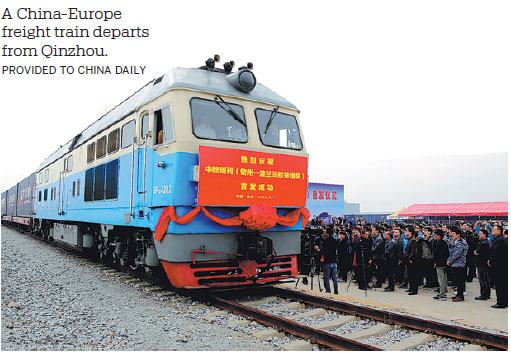Guangxi a key cog in success of trade route
Updated: 2019-09-20
Land-sea trade corridor greatly reduces travel time of seaward exports from western and central China, officials with the province say.
The Guangxi Zhuang autonomous region has developed into a crucial hub of the New International Land-Sea Trade Corridor as a result of blossoming cooperation with China's inland regions and neighboring countries.
The new land-sea corridor is an international trade and logistics passageway jointly built by western Chinese provinces and Southeast Asian countries under the framework of the China-Singapore (Chongqing) Demonstration Initiative on Strategic Connectivity, an agreement signed between the Chinese and Singaporean governments in November 2015.
With Chongqing municipality serving as one of its transportation hubs, the corridor uses ports in Guangxi's Beibu Gulf coasts to provide access to Singapore and other Association of Southeast Asian Nations members by sea, and links with China-Europe freight trains coming from many western Chinese cities before heading to Central Asia, South Asia and Europe.

Clockwise from top: Fangchenggang has one of the busiest ports in the Beibu Gulf region. The Hengyang-Liuzhou High-Speed Railway has slashed the travel time between Guangxi and the central part of China. Nanning Comprehensive Bonded Area is an important part of the land-sea trade corridor. [Photos provided to China Daily]
In August 2017, Guangxi, Chongqing, Guizhou province and Gansu province signed agreements to cooperate in developing the corridor. Qinghai province and the Xinjiang Uygur autonomous region came on board in June and November 2018. Yunnan province and the Ningxia Hui autonomous region were the latest regions to join the program.
The land-sea corridor can greatly shorten the travel distance of seaward exports from China's western and even central region, according to Guangxi's officials.
They said exports from Chongqing, for instance, are traditionally shipped via the Yangtze to Shanghai and then transshipped to larger vessels. The trip on the 1,800-kilometer Yangtze waterway takes more than 10 days.
In contrast, it takes only two days to transport Chongqing's cargoes to Beibu Gulf via railway. Guangxi also offers the shortest passageway for western China's freight to ASEAN, and other regions in the world through the Malacca shipping route.
In the past two years, Guangxi has promoted cooperation with other Chinese regions and neighboring countries engaged in this initiative.
These include agreements for implementation measures between Guangxi and other Chinese regions, as well as a memorandum between Guangxi regional government and the Ministry of Trade and Industry of Singapore.
In addition, Guangxi also held promotional events in Singapore in May and in China's Hong Kong Special Administrative Region in July.
A number of key projects have been carried out in Guangxi to improve its land and sea transportation and information interconnectivity with its neighboring regions and countries.
One of the landmark projects under the new land-sea corridor initiative is the Qinzhou Railway Container Central Station.
Construction of its first phase, which covers an area of about 85 hectares, began in July 2017.
According to Wei Ran, deputy chief of the Beibu Gulf affairs office at the regional government of Guangxi, the station has a designed annual handling capacity of 1.05 million containers, compared with the city's annual throughput of 150,000 railway containers before the operation of the new station.
The central station was officially put into operation on June 30, as a China-Europe freight train loaded with 70 container cargoes departed from Qinzhou, to Duisburg, Germany.
Construction of another key project for railway transportation, the first phase of Nanning International Railway Port, was completed at the end of last month.
Construction of other transportation and logistics facilities, including a railway logistics center in the border city of Pingxiang and an expansion project of the Fangchenggang Port, has also been completed.
Guangxi will accelerate construction on the Huangtong-Baise Railway, the Hunan-Guangxi Railway's Nanning-Pingxiang section and the Nanning-Kunming Railway's Weishe-Baise section. Qinzhou Port will add a 200,000-metric-ton container terminal and have its eastern shipping lane expanded.
More direct freight trains will be launched to connect Chongqing with Beibu Gulf, and more shipping routes will connect Beibu Gulf with ASEAN countries.
The China-ASEAN Information Port, which was proposed at the first China-ASEAN Cyberspace Forum in 2014, is a program for internet connectivity, information sharing and cultural exchanges between China and ASEAN members. It features five platforms for infrastructure construction, information sharing, technological cooperation, economic and trade services.
According to executives of China-ASEAN Information Harbor Corp, the company that takes charge of the program's operation, the information harbor has made breakthroughs in infrastructure construction and promotion of IT-related businesses in regions involved in the program.




